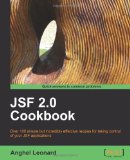This book covers the new features of JSF 2 in the form of about 1OO hundred recipes.
In my opinion these recipes give a good overview of the new capabilities of the latest version of JSF.

The chapters get right to the point with very common problems/requirements in web development and their solutions.
Of course you still need to read more documentation about JSF 2 (such as the complete reference) to be able to completely understand and know the different options.
The main IDE and the server used in the book are NetBeans 6.8 and GlassFish 3, respectively.
The IDE Eclipse Ganymede is used in one recipe (Using JSF ID generator).
The first two chapters give a good idea of the custom and standard validators and converters.
Apache MyFaces Trinidad and RichFaces are used. Validation is also demonstrated through the built-in integration of JSR-303 (Bean validation) in JSF 2.
Chapter 3 is about file management (uploading, downloading, extraction, export) with the help of Mojarra Scales libraries, RichFaces and PrimeFaces components.
Chapter 4 is another interesting chapter that explores various ways to protect a site. It demonstrates the use of EL expressions part of the JSF Security project which uses a separate scope called securityscope.
Roles are based on JAAS, stored in a database or added to the HttpSession. The last recipe makes use of Spring Security to manage a login page.
Chapter 5 provides recipes to demonstrate the creation of various custom components (hello world, image slide viewer with Ajax functionality using the Dynamic Faces project etc) and also composite custom components.
Chapter 6 is about Ajax. It covers the new tag
to add Ajax features (Dynamic Faces, Tomahawk, ajax4jsf, PrimeFaces …).
Chapter 7 is about the frequent site requirements that are internationalization and localization.
It uses the core tag f:loadBundle, messages properties files, encoding …
Chapter 8 shows how to add CSS styles to JSF tags, populate grids with CSS styles, integrate JavaScript
to JSF with various examples, retrieve images from a database and provide them dynamically to a JSF page.
There is even a recipe that shows how to use the tag libary rss4jsf to show RSS content in JSF pages.
Chapter 9 introduces various applications :
– the Faces Console tool to visually edit JSF configuration files
– JSFUnit (JBoss framework for testing JSF applications)
– JMeter to measure performance
– JSF Chart Creator to diplay charts
Chapter 10 is an important one since it is about Facelets which, starting with JSF 2.0, is a part of the JSF specification and the recommended presentation technology to use in conjunction with JSF. Templating and composition components are the topics most discussed in this chapter.
Chapter 11 is a set of seven recipes about new features in JSF 2.0 that were not seen in the previous chapters.
Finally chapter 12 is another useful chapter since it shows how to integrate JSF with other technologies such as Spring and EJB
The appendix contains listings of the configuration files for JSF-related frameworks.
What i liked most : the recipes are based on frequent requirements and problems encountered
when developing. So they are really useful.
What i liked the least : nothing really negative to report. This book of recipes meets the idea and expectations I had of it before reading it.
Table of contents :
Chapter 1: Using Standard and Custom Converters in JSF
Chapter 2: Using Standard and Custom Validators in JSF
Chapter 3: File Management
Chapter 4: Security
Chapter 5: Custom Components
Chapter 6: AJAX in JSF
Chapter 7: Internationalization and Localization
Chapter 8: JSF, Images, CSS, and JS
Chapter 9: JSF—Managing and Testing
Chapter 10: Facelets
Chapter 11: JSF 2.0 Features
Chapter 12: Mixing JSF with Other Technologies
Appendix: Configuring JSF-related Technologies
You can order the book on Packt Publishing’s website http://www.packtpub.com/jsf-2-0-cookbook/book.